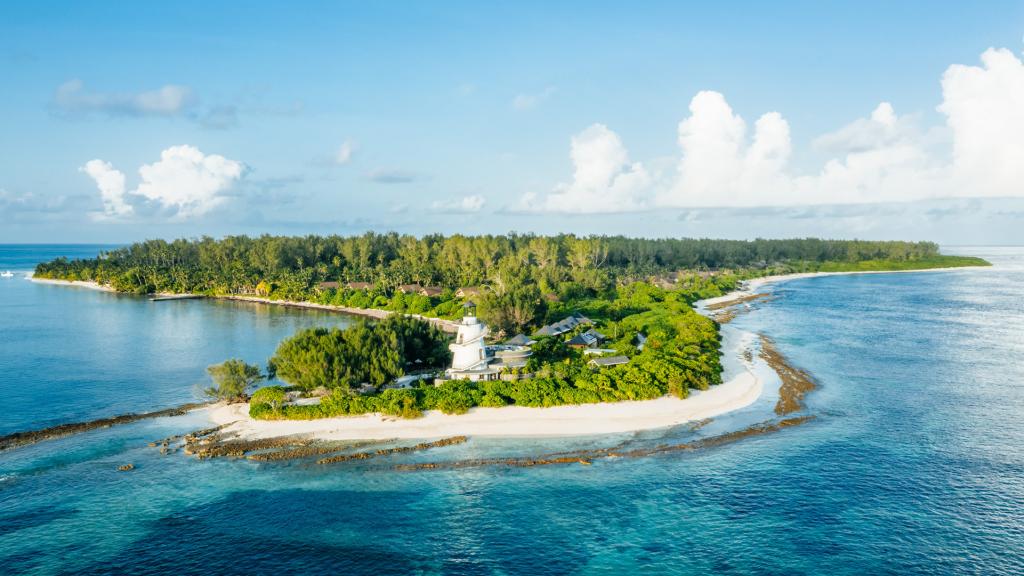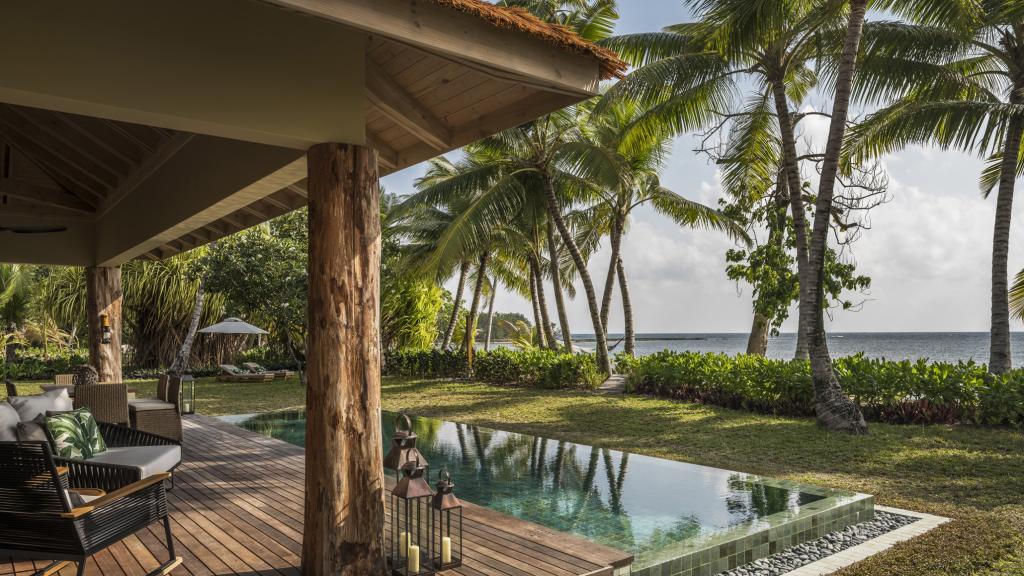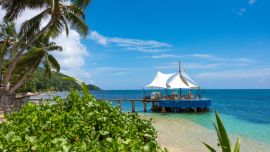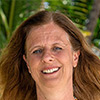Amirantes
Approximately 250 km (155 miles) south of Mahé, the coral Outer Islands begin, totalling 73 different islands and atolls. With an area of more than 200,000 square kilometres, these islands make up about half of the country's entire land mass, but less than 2% of the Seychelles' population. One of the larger groups is the Amirantes, which consists of Desroches, African Banks, Rémire, D'Arros, St. Joseph, Poivre, Étoile, Boudeuse, Marie Louise, and Desnoeufs.
These islands were discovered in 1502 by Portuguese explorer Vasco de Gama, and named the "Ilhas do Almirante" (the Islands of the Admirals). Unlike some of the other islands that have incredible natural wonders to offer, the small islands of the Amirantes can be visited for more than a day trip by tourists, as there is even a hotel on one of them. The Amirantes are well-worth a visit thanks to their incredible flora and fauna. The coral reefs around the islands are also imposingly beautiful, and house clownfish, lionfish, and boxfish, as well as colourful parrotfish and sea anemones.
Desroches
The island of Desroches is only 3.2 square kilometres in size, and lies 230 km (142 miles) south-west of Mahé amongst the so-called Amirantes. Although historically the island was well-known for its copra production, with its produce ranking among the most valuable in the Indian Ocean, it has more recently been earmarked for tourism. To this end, the Four Seasons Resort Desroches Island, a luxury hotel with 80 or so rooms, was built. From here, you can explore the island on foot or by bike, as well as go on excursions to some of the neighbouring islands. In addition, you can go kayaking, play tennis or take part in a cooking class. As mentioned, the island is a veritable eldorado for diving, as Desroches is located on an underwater atoll ring, which sinks into the depths of the ocean with tunnels, ravines, and crevices, ensuring fascinating diving scenery. The best conditions for diving can be found between November and May. In fact, those who wish can even undertake a diving course thanks to the hotel's Diving School.
The island's coastline is 14 km (9 miles) long in total, and consists almost entirely of fine white sand. The island's landing jetty is served five times per week from Mahé, making Desroches the easiest of the Amirantes islands to reach, as well as the hub of the group. From the lighthouse on the east of the island, you have a really fantastic view of the ocean. In terms of nature, the island is home to many bird species, including the Seychelles weaver, the white tern, and the zebra dove. The island also houses turtles who come to lay their eggs on the beach. The island was given its name in 1771 after Chevalier de Roslan, who was captain of the L'Heure du Berger ship, and wanted to remember the Chevalier des Roches, who was at the time governor of the Iles de France et de Bourbon, what nowadays is Réunion.
African Banks
The shrub-lined sand banks of African Banks take up a total of 10 square kilometres, and are a real refuge for thousands of sea-faring birds. How the island got its name isn't entirely clear, but it was discovered in 1797 by Admiral Willaumez, who supposedly called it the Ilots Afraicains. 10 km (6 miles) north-west of the island, there is an extremely shallow patch of ocean that is dangerous for ships, the so-called Lady Denison Pender Sandbank.
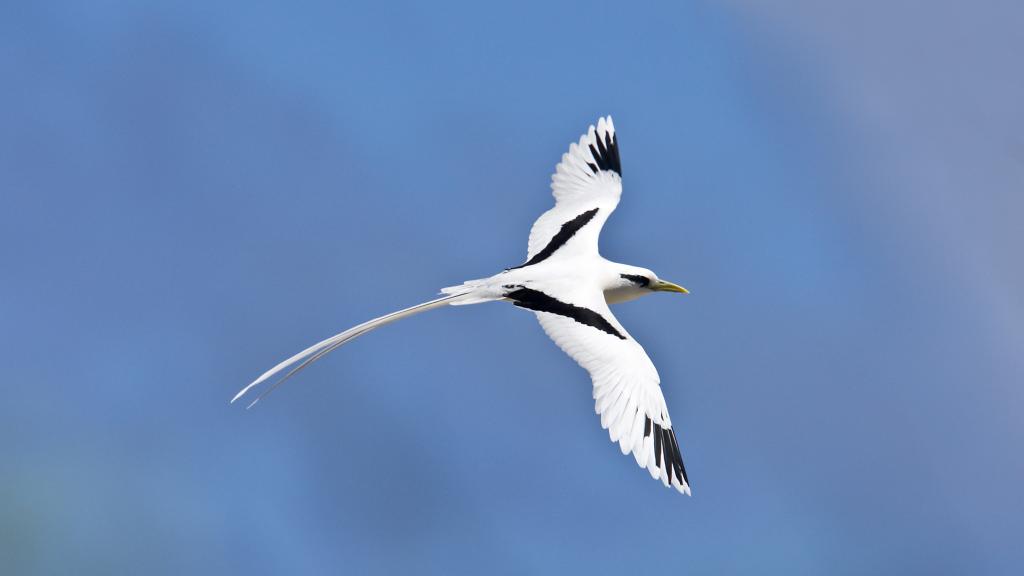
Rémire
Rémire, also know as Eagle Island, is the northernmost inhabited island in the Amirantes, and is just 0.27 km² in size. This oval island is thickly-vegetated, but rarely rises to more than 3 metres above sea level. The island used to be used for guano production, as well as the growth of coconuts and vegetables. These days, the island houses a small hotel, and is also home to a 457-metre runway, which for a long time was used as a weekend retreat by the country's President. Around 3 km north-east of the island is the Rémire reef, which is approximately 10 km² in size.
D’Arros & St. Joseph Atoll
D'Arros and the St. Joseph Atoll, along with its unique ring of smaller islands, belong to what was once the Iranian royal family. Until 2012, D'Arros was owned by L'Oréal heiress Liliane Bettencourt, who sold the island for 60 million US Dollars. On the island, there is a small landing strip and a hotel. Both of these two islands are home to numerous wedge-tailed shearwater birds, along with other bird species, while the largest of the atoll's islands is home to casuarina plants. Historically, this would have been coconut trees.
Poivre
Poivre also an atoll, and around 38 km (23 miles) south-west of the Desroches atoll, was once used as a coconut and vanilla plantation, and it even nowadays still inhabited. The whole reef platform on which the atoll sits is more than 20 square kilometres in size.
Étoile und Boudeuse
Étoile is almost completely devoid of vegetation, and is just 0.01 square kilometres in size. This flat island rises to just 5 metres above sea level. Along with Boudeuse, the island is uninhabited. Both islands serve as nesting grounds for the sooty tern bird.
Marie Louise & Desnœufs
Marie Louise and Desnœufs were, once upon a time, used for guano production. In the 1980s, humans tried to develop Marie Louise for touristic use, and built a few small houses to this end on the island. However, restrictions were put in place regarding air traffic around the island, as the numerous birds that fly in the area made landing a plane on the island impossible, or at least dangerous. Besides that, landing on this 3 metre-high island with a boat is also complicated due to the rocky edges of the island. There are, therefore, only a few people who live here permanently. The northern coast of Desnœufs is home to a few buildings that are sometimes used by scientists and researchers, especially those who are interested in the numerous breeding species of sea-faring birds who use the island.
